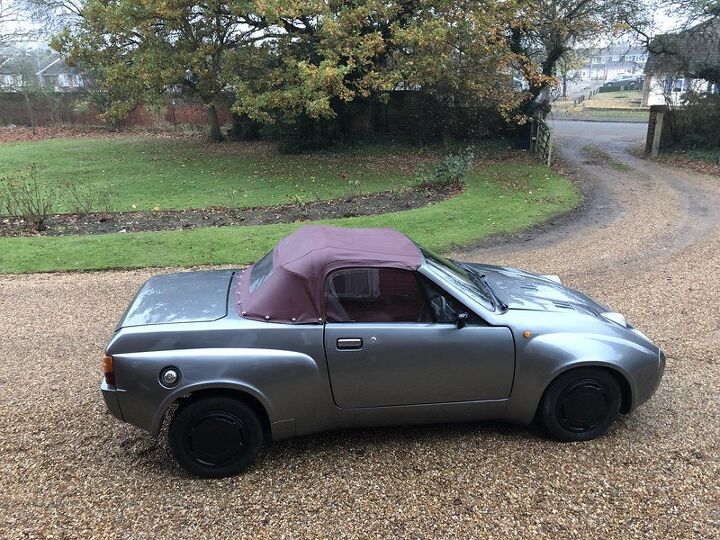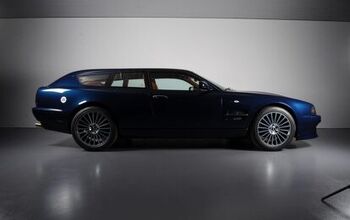Rare Rides: This Midas Gold From 1998 Is Grey

Every once in a while, a car surfaces from the vast internet that truly deserves the title of “obscure.” It happened previously with a beautiful Gordon Keeble, and now Rare Rides is proud to present another very obscure British two-door.
It’s a Midas Gold, obviously.
Though the Midas entered production as a kit car in 1978, its roots lie further back in history with the Marcos brand (which Rare Rides covered previously). Marcos started building its Mini Marcos kit cars in 1965. The cash-strapped company was still building the same car in 1975, and needed assistance. Enter fiberglass company D&H Fiberglass Techniques. Marcos inked a deal with D&H to rework and manufacture a new version of the Mini Marcos.
By 1978 a revised coupe was ready, entering showrooms as the Midas. Like the Marcos, the Midas utilized a fiberglass body and Mini underpinnings. The first-generation model saw a host of updates for 1981 after slightly famous racing person Gordon Murray made some suggestions to D&H.
The company improved its Midas again in 1985. A visual rework added frogeye lamps, larger windows, and better aerodynamics thanks to additional input from Gordon Murray. The Midas now wore bodywork and parts based on the MG Metro. D&H then expanded the Midas range to include fully-finished vehicles after subjecting the Midas to Euro-standard crash testing. By the end of the Eighties, a convertible Midas joined the coupe in the lineup. Things at D&H were getting hot.
Literally.
The factory in Northamptonshire burned down in March 1989. Production ground to a halt. Midas brand ownership changed hands in 1990, 1991, 2001, and 2003. The brand is presently owned by Alternative Cars Limited, which builds the traditional Gold convertible, as well as new models developed in the Nineties: Excelsior and Cortez. The Gold coupe’s moldings was sold off separately to the government of Berlin, Germany in 1990, and coupes were not produced after that time.
Today’s 1998 Midas Gold was built during the ownership of a Nottinghamshire company called GTM Cars. Their ownership saw additional development of the Gold, with a Hydragas suspension and optional hardtop added to the convertible. Offering a 998cc engine and manual transmission, the Gold also has a heater. This one is for sale right now in England, and asks $5,000.
[Images: seller]

Interested in lots of cars and their various historical contexts. Started writing articles for TTAC in late 2016, when my first posts were QOTDs. From there I started a few new series like Rare Rides, Buy/Drive/Burn, Abandoned History, and most recently Rare Rides Icons. Operating from a home base in Cincinnati, Ohio, a relative auto journalist dead zone. Many of my articles are prompted by something I'll see on social media that sparks my interest and causes me to research. Finding articles and information from the early days of the internet and beyond that covers the little details lost to time: trim packages, color and wheel choices, interior fabrics. Beyond those, I'm fascinated by automotive industry experiments, both failures and successes. Lately I've taken an interest in AI, and generating "what if" type images for car models long dead. Reincarnating a modern Toyota Paseo, Lincoln Mark IX, or Isuzu Trooper through a text prompt is fun. Fun to post them on Twitter too, and watch people overreact. To that end, the social media I use most is Twitter, @CoreyLewis86. I also contribute pieces for Forbes Wheels and Forbes Home.
More by Corey Lewis
Latest Car Reviews
Read moreLatest Product Reviews
Read moreRecent Comments
- Kjhkjlhkjhkljh kljhjkhjklhkjh A prelude is a bad idea. There is already Acura with all the weird sport trims. This will not make back it's R&D money.
- Analoggrotto I don't see a red car here, how blazing stupid are you people?
- Redapple2 Love the wheels
- Redapple2 Good luck to them. They used to make great cars. 510. 240Z, Sentra SE-R. Maxima. Frontier.
- Joe65688619 Under Ghosn they went through the same short-term bottom-line thinking that GM did in the 80s/90s, and they have not recovered say, to their heyday in the 50s and 60s in terms of market share and innovation. Poor design decisions (a CVT in their front-wheel drive "4-Door Sports Car", model overlap in a poorly performing segment (they never needed the Altima AND the Maxima...what they needed was one vehicle with different drivetrain, including hybrid, to compete with the Accord/Camry, and decontenting their vehicles: My 2012 QX56 (I know, not a Nissan, but the same holds for the Armada) had power rear windows in the cargo area that could vent, a glass hatch on the back door that could be opened separate from the whole liftgate (in such a tall vehicle, kinda essential if you have it in a garage and want to load the trunk without having to open the garage door to make room for the lift gate), a nice driver's side folding armrest, and a few other quality-of-life details absent from my 2018 QX80. In a competitive market this attention to detai is can be the differentiator that sell cars. Now they are caught in the middle of the market, competing more with Hyundai and Kia and selling discounted vehicles near the same price points, but losing money on them. They invested also invested a lot in niche platforms. The Leaf was one of the first full EVs, but never really evolved. They misjudged the market - luxury EVs are selling, small budget models not so much. Variable compression engines offering little in terms of real-world power or tech, let a lot of complexity that is leading to higher failure rates. Aside from the Z and GT-R (low volume models), not much forced induction (whether your a fan or not, look at what Honda did with the CR-V and Acura RDX - same chassis, slap a turbo on it, make it nicer inside, and now you can sell it as a semi-premium brand with higher markup). That said, I do believe they retain the technical and engineering capability to do far better. About time management realized they need to make smarter investments and understand their markets better.







































Comments
Join the conversation
"The factory in Northamptonshire burned down in March 1989. Production ground to a halt." Paging Captain Obvious! ;-)
"The Gold coupe’s moldings was sold off separately to the government of Berlin, Germany in 1990, and coupes were not produced after that time." This sentence seems rather unclear. What was sold to Berlin? Next question ... why?